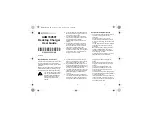
14
Figure 5-5
The available setting contents are:
Charging state (boost/float): in this case, operator could set the present step as “boost” or
“float”. After setting, it would display in the charging state screen and charger panel.
Charge mode (constant voltage/constant current):
constant voltage mode or constant current
mode could be chosen.
Value:
Setting the voltage value of constant voltage mode and the current value of constant
current mode.
Set Time:
Setting the charging time for the present step.
Next step:
When the "Set Time" or the “Jump Term” meets the condition, then goes on the
"next step" and sets any step from 0 to 5. If sets among 1 to 5, it means the step is what the
value for after meeting the leaping condition. If sets as 0, it means stopping charging when
meets the condition.
Jump Term:
Setting the jump term condition. When charging voltage or current reaches this
adjustment, it would leap and leap to the step of setting “next step”. Minus means leaping if it
is less than the value. No symbol means leaping if it is more than the value.
Limiting current (voltage): if it is a constant voltage charging mode, the term would display as
limiting current, showing the max. current shall not over the rated value. If it is a constant
current charging mode, the term would display as limiting voltage, showing the max. voltage
shall not over the rated value.
The steps of setting charging: charging setting screen could set five charging steps. Each step
could set charging state, charging mode, values, time, next step, jump term, limiting current
(voltage) etc. The five steps could realize the cyclic charging process.
For example, a 48V200AH battery bank firstly needs constant current charging with 40A. when
the voltage reaches 56.4V, constant voltage equalized charging with 56.4V. if the current is less
than 4A, float charging with 54V. if the current is more than 16A, it would leap to the second
step.












































